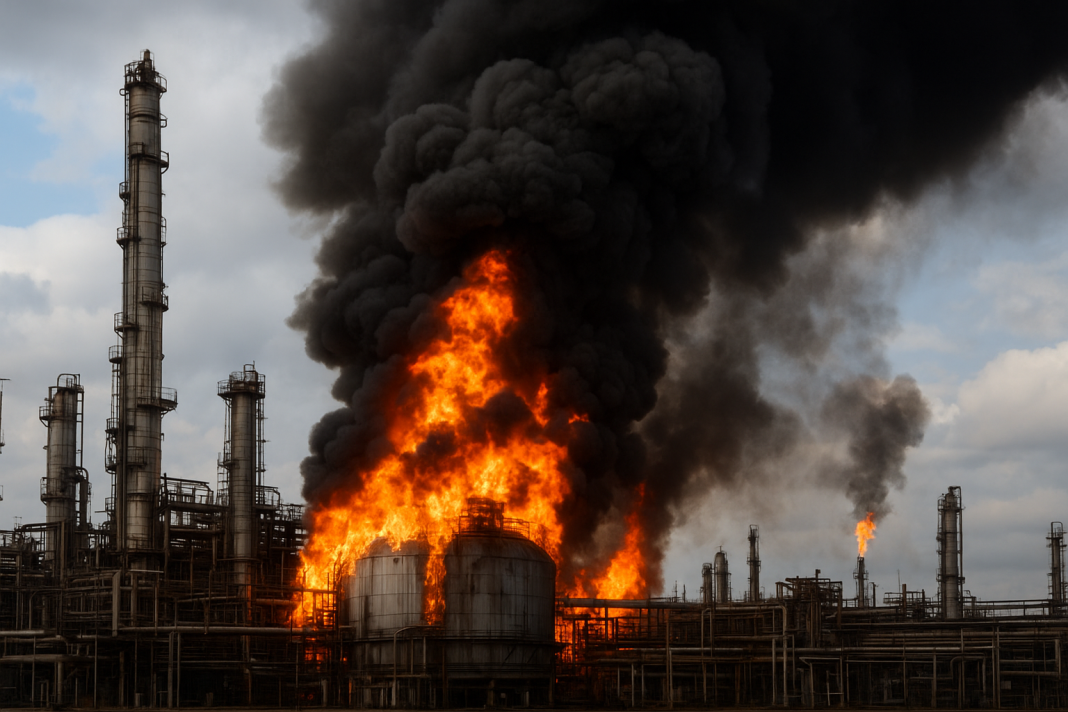Ukraine has carried out a fresh attack on Russian energy infrastructure, targeting the Ryazan oil refinery. The strike was confirmed through military sources, who stated that unmanned aerial vehicles, commonly known as drones, were used in the operation.
Attack on the Ryazan Oil Refinery
The Ryazan oil refinery is one of Russia’s important facilities for processing crude oil into usable products like gasoline, diesel, and jet fuel. Located southeast of Moscow, this site plays a crucial role in supporting both the civilian economy and the country’s logistics. By striking this refinery, Ukraine has once again shown its ability to reach deep into Russian territory.
Local reports suggest that explosions and fire broke out inside the Ryazan oil refinery after the attack. Emergency crews were deployed to control the situation and prevent further damage. The extent of destruction has not been fully confirmed, but eyewitness accounts indicated visible flames and smoke rising from the site.
Precision drone attack turns Volgograd oil refinery into towering fireball
This strike on the Ryazan oil refinery marks one of several recent attempts by Ukraine to weaken Russian fuel and energy supplies. Such operations are part of the ongoing conflict that has stretched for more than two years, with both sides trying to hit targets that directly affect each other’s capabilities.
Luhansk Oil Depot Also Hit
Alongside the Ryazan oil refinery attack, Ukrainian forces also carried out a strike on an oil depot in the Luhansk region. This area, currently under Russian occupation, has been used as a hub for storing and distributing fuel.
The depot reportedly held large reserves of oil products. Ukrainian drones managed to penetrate the defenses of the facility, causing significant damage. Local officials in the area admitted that the site was hit, and firefighting units were seen working to bring the situation under control.
Ukraine’s Drone Strike Ignites Chaos at Russia’s Ilsky Oil Refinery
Luhansk is a strategically important region in eastern Ukraine. For months, it has been a battleground where Russian troops maintain strong positions. Fuel depots there serve as lifelines for supplying military vehicles and equipment. By targeting these depots, Ukraine aims to disrupt those supply chains.
The simultaneous attacks on both the Ryazan oil refinery and Luhansk highlight Ukraine’s continued focus on Russia’s energy network. These operations underline how drones are now central tools in modern warfare. They allow militaries to strike from afar, bypassing traditional defenses.
Escalation of Strikes on the Ryazan Oil Refinery and Energy Sites
The Ryazan oil refinery is not the first facility to be targeted in recent weeks. Ukraine has repeatedly launched strikes against oil refineries, storage depots, and pipelines inside Russian territory. Each strike has brought temporary disruption to fuel production and distribution.
Russian energy infrastructure is vast, but attacks on critical hubs like the Ryazan oil refinery demonstrate Ukraine’s growing reach. These strikes are designed to cause both logistical challenges and psychological pressure. The visibility of smoke and fire at such important facilities creates strong symbolic effects as well.
Security analysts note that attacks on oil facilities can ripple through wider supply chains. Fuel is central not only for military operations but also for transportation, agriculture, and daily civilian use. A strike on a refinery, even if damage is limited, forces emergency responses, investigations, and repairs that strain local resources.
🔥 Explosive Ukranian drone strike ignites massive fire at Saratov oil refinery in Russia
In the past, Russian defenses have intercepted some Ukrainian drones before they could reach their targets. However, the success of the Ryazan oil refinery and Luhansk strikes shows that many drones are still able to break through. As the conflict continues, both sides have invested heavily in air defenses, yet neither has been able to stop such attacks entirely.
The attacks also show how the battlefield is no longer limited to front-line trenches or occupied cities. Critical infrastructure deep inside both countries is now exposed. Oil facilities, power plants, and depots are increasingly seen as valid targets in this struggle.

